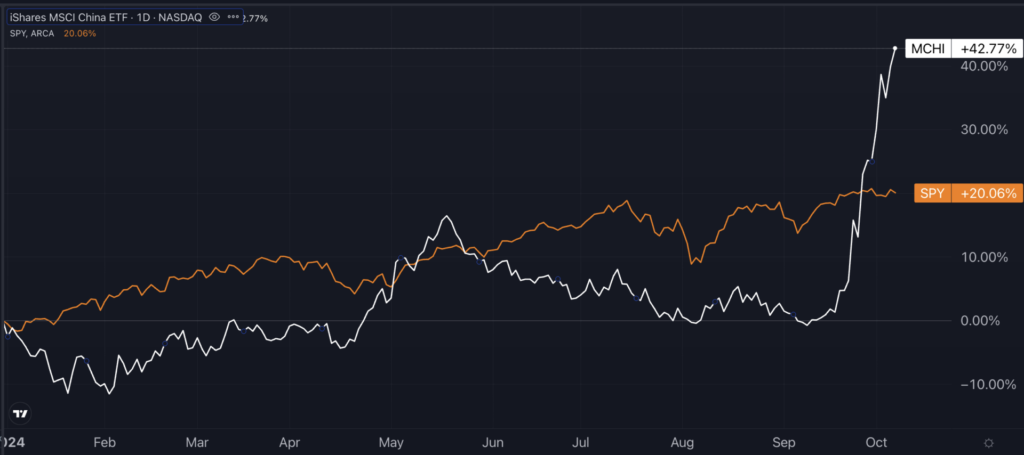Zinger Key Points
- Chinese equities surged 35% between Sept. 24 and Oct. 7, with the MSCI China Index more than doubling S&P 500 year-to-date performance.
- Bank of America analysts warn of potential pullbacks, advising long-term investors to accumulate large-cap internet stocks.
- Markets are swinging wildly, but for Matt Maley, it's just another opportunity to trade. His clear, simple trade alerts have helped members lock in gains as high as 100% and 450%. Now, you can get his next trade signal—completely free.
Chinese equities have staged a dramatic comeback in the past few weeks on the back of policy stimulus, with the MSCI China Index, tracked by the iShares MSCI China ETF MCHI, surging over 35% between Sept. 24 and Oct. 7.
This “fast and furious” rally, as described by Bank of America analysts Winnie Wu and Willie Chan, outpaced the performance of other major markets globally and more than doubled the year-to-date gains of the S&P 500, as tracked by the SPDR S&P 500 ETF Trust SPY.
The rally has been driven by a series of aggressive monetary easing policies unveiled by Chinese authorities, alongside renewed government commitments to stabilize the country’s troubled property sector.
Year-To-Date Performance: MSCI China Doubles S&P 500

A $2 Trillion Market Surge
From Sept. 23 to 30, the MSCI China Index added nearly $2 trillion in market capitalization. Some of the largest beneficiaries were blue-chip companies like Kweichow Moutai, which jumped 39% (adding $88 billion in market cap), Tencent Holdings ADR TCEHY, which climbed 15% (adding $70 billion) and Alibaba Group Holding Ltd. – ADR BABA, which surged 27%, increasing its market value by $58 billion.
This rapid market appreciation reflects growing optimism among investors that China's policymakers are taking serious steps to address the country's economic challenges, including deflationary pressures, a property market downturn and mounting local government debt.
Key Stimulus Measures Fuel The Rally
The rally was sparked by a series of unexpected policy announcements starting on Sept. 23. That day, the People's Bank of China (PBoC) surprised markets by cutting its 14-day reverse repurchase rate by 10 basis points to 1.85%, injecting approximately $10.6 billion (74.5 billion yuan) into the banking system.
The following day, the PBoC Governor Pan Gongsheng announced a more substantial measure: the central bank would cut the reserve requirement ratio by 50 basis points, injecting about $142.5 billion (one trillion yuan) into the financial system. In addition, the seven-day repo rate was reduced by 20 basis points, and the central bank pledged to lower benchmark loan prime rates and existing mortgage rates by around 50 basis points, potentially reducing household interest payments by about $21 billion (150 billion yuan).
Further easing came on Sept. 25, when the PBoC lowered its one-year medium-term lending facility (MLF) rate by 30 basis points, followed by fiscal pledges to inject capital into state-owned banks.
Last but not least, the PBoC ordered commercial banks to reduce interest rates on existing mortgages, with rates no less than 30 basis points below the Loan Prime Rate before Oct. 31.
Chinese Equity ETFs Post Massive Gains
These moves have propelled Chinese equity ETFs to outperform the S&P 500 and other global benchmarks by a significant margin. From Sept. 24 to Oct. 7, several China-focused ETFs posted eye-whopping gains:
- Invesco China Technology ETF CQQQ: +52%
- iShares MSCI China A ETF CNYA: +48%
- XTrackers Harvest CSI 300 China A-Shares ETF ASHR: +47%
- WisdomTree China ex-State-Owned Enterprises Fund CXSE: +43%
- KraneShares CSI China Internet ETF KWEB: +40%
- SPDR S&P China ETF GXC: +38%
- Invesco Golden Dragon China ETF PGJ: +36%
- iShares China Large-Cap ETF FXI: +32%
Caution Ahead: Potential for Pullbacks
While the rally has been robust, analysts at Bank of America advise caution.
“More fiscal stimulus to stabilize the property market and restructure local government debts, and structural reforms to address the over-capacity/deflation issues are needed to turn around the economy,” they wrote.
In their report, analysts warn the current “buy everything” stage may soon end, particularly if no further positive catalysts materialize.
High-beta consumer, property and broker stocks, which have rallied sharply, could be the first to experience profit-taking. However, the analysts suggest long-term investors could view any potential pullbacks as buying opportunities, particularly in sectors like large-cap internet stocks and high-yield state-owned enterprises (SOEs), which they consider less volatile.
For the fourth quarter of 2024, Bank of America remains constructive on several sectors, including internet (media, online retail), insurance, and health care, particularly in life sciences and biotech, which delivered strong performance in the third quarter.
They are cautious about brokerage stocks after the strong rally and have downgraded utilities (gas, water) due to earnings downgrades and unattractive valuations. Additionally, they remain bearish on the property, auto, construction materials and chemicals sectors, as they believe a fundamental recovery in these areas will take more time.
Read Now:
Photo: Shutterstock
Edge Rankings
Price Trend
© 2025 Benzinga.com. Benzinga does not provide investment advice. All rights reserved.
Trade confidently with insights and alerts from analyst ratings, free reports and breaking news that affects the stocks you care about.